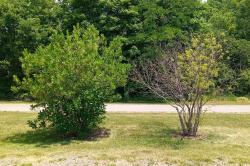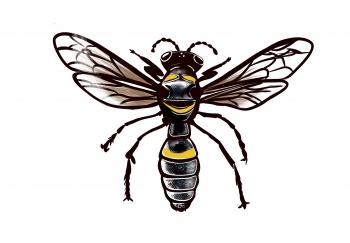The emerald ash borer undergoes complete metamorphosis (is holometabolous) with four life stages: egg, larva, pupa, and adult. Adults are a dark green metallic color and approximately ½ inch long. They are the only Agrilus species in North America known to have a bright metallic coppery-red (may also appear purple) dorsal surface of their abdomen. (The wings must be lifted to see that feature.) Larvae are white, 1 to 1.25 inches long at maturity, have a small brown head, a pair of brown pincers at the end of the abdomen, and have bell-shaped abdominal segments. The fourth instar larvae overwinter in a pre-pupal stage in a J-shaped position. Pupae are present in the spring and look like cream-colored adults that begin to darken as they develop. The larval and pupal stages are found beneath the bark of their host trees, as the larvae feed on the nutrient and water conducting tissues of the plant. Adults emerge in May and June and mate and lay tiny, flat, oval shaped eggs that are initially whitish-yellow in color and turn reddish-brown as they develop. Eggs are difficult to see as they are approximately 1/32 of an inch and laid in cracks and crevices of the bark. On average, females can lay 55 eggs in their lifetime, but some have been observed laying more than 150 eggs. Adult emergence creates D-shaped exit holes in the bark.
Although adult emerald ash borer will conduct some maturation feeding (on ash foliage), it is the larval stage of this insect that causes the most amount of damage to ash trees. Larvae create S-shaped feeding galleries beneath the bark which lead to the eventual girdling of the tree. Vertical splits or cracks can also form in the bark over these larval galleries. Heavily infested trees exhibit canopy dieback, beginning at the top of the tree. Some ash trees will push water-sprouts or epicormic shoots from their base or branches. D-shaped exit holes are created by the emerging adults. “Blonding,” or evidence of woodpecker feeding activity on emerald ash borer larvae, may be visible on the bark. This occurs as the woodpeckers forage for the insects, leading to the removal of the outer bark, exposing the lighter-colored inner bark. This can be a very visible sign that there may be emerald ash borer present. Emerald ash borer will attack healthy ash trees, although adults may prefer to feed on or lay eggs on stressed trees. When emerald ash borer populations are high, small trees can die within 1-2 years of initial infestation, while larger trees may take 3-4 years before succumbing to this pest.
A note about white fringetree: while this host plant is not a preferred host of emerald ash borer, it will be attacked when the population of this insect is high in nearby ash. The following information is courtesy of Dr. Don Cipollini, Wright State University, Dayton, Ohio: "[White fringetrees] continue to get attacked occasionally, sometimes severely. [Here is a picture]...of two fringetrees along a bike trail. The one on the right was heavily attacked by EAB in the last two years, while the one of the left was virtually untouched as of yet. This displays the sort of variation in attack we've seen on these trees. As for whether you should treat, it probably would be worth treating a prized 100-year old tree. You could treat a fringetree with the same formulations and frequency as for ash trees, with a caveat that a root drench may work best due to the multi-stemmed nature of these trees. If you do, however, you should recognize that white fringetree has flowers that are visited by pollinators and it produces fruits that are consumed by mammals and birds and such, so there is greater potential for non-target effects than for ash trees. As you can see in the pic[ture], EAB will attack relatively small trees too, so although larger and older are likely bigger targets on average, we've seen trees down to 4 feet tall and an inch in diameter being attacked."

Ash trees exhibiting blonding (from feeding woodpeckers) in Massachusetts are very likely infested with the emerald ash borer. This invasive insect is now widespread throughout much of Massachusetts. Check these trees for the presence of D-shaped exit holes on the trunk and S-shaped galleries beneath the bark. Epicormic shoots may also be present on EAB-stressed hosts. Various different types of insect traps and lures are available for monitoring for emerald ash borer, although those activities may no longer be necessary in Massachusetts, again, due to the widespread distribution of this insect. Emerald ash borer is lethal to Fraxinus spp. and any specimen trees that need to be protected will likely require immediate chemical intervention. Monitoring for emerald ash borer can also be done via biosurveillance, by observing prey brought back to nests created by the native, non-stinging wasp known as the smokey-winged beetle bandit (Cerceris fumipennis). This wasp nests in hard-packed, sandy soils and collects both native and invasive jewel beetles, including the emerald ash borer. This wasp is a predator of these jewel beetles, and should be preserved in our landscapes.
Infested trees showing more than approximately 30% canopy loss may not recover even with chemical management options. In managed landscapes, particularly in areas near buildings or other structures, infested or dying ash trees should be removed before they become hazardous. Consult a qualified arborist. Arborists should take great care when working with dead/dying ash trees, as they are known to become extremely brittle and prone to breaking very quickly. A comparative study of ash trees conducted in Ohio shows that structural integrity of ash trees can begin to decline even when trees are mostly green and have 2/3 of the canopy still intact. Many arborists refuse to climb declining ash trees for their own safety.
Green ash, black ash, and Oregon ash decline more rapidly than white ash cultivars in common garden studies; variation in susceptibility is known. European ash species also decline rapidly, including Fraxinus ornus, F. excelsior 'Aureafolia', and F. angustifolia subsp. oxycarpa 'Raywood'. Manchurian ash (F. mandshurica) has the highest survival rate and little canopy decline, and appears to be quite resistant.
Biological control organisms are available for the management of this insect and have been released in Massachusetts by state and federal agencies and researchers. These include Oobius agrili, a tiny parasitoid wasp that attacks the eggs of emerald ash borer; Spathius agrili, a parasitoid wasp of the larvae of emerald ash borer; and Tetrastichus planipennisi, another larval parasitoid wasp. All three of these insects were isolated from emerald ash borer populations in China and tested for host specificity (to determine that they only attack emerald ash borer) prior to approval for their release in the United States. A fourth species has been approved for release in the US, Spathius galinae, a larval parasitoid wasp from eastern Russia. The hope is that, given time, this complex of biological control organisms can catch up to the populations of emerald ash borer and keep this invasive insect at densities below our tolerance threshold, particularly in forested settings, allowing the survival of our native ash tree species.
Woodpeckers have also been found to be significant predators of emerald ash borer larvae. It is interesting to note that woodpeckers are capable of eating 30-95% of the emerald ash borer larvae found in a single tree (Murphy et al. 2018).
Abamectin (NL)
Acephate (NL)
Azadirachtin (NL)
Bacillus thuringiensis subsp. galleriae (NL)
Beauveria bassiana (NL)
Bifenthrin (NL)
Chlorpyrifos (N)
Dinotefuran (NL)
Emamectin benzoate (L)
Imidacloprid (L)
Pyrethrins + piperonyl butoxide (L)
Spinosad (NL)
Reminder: this information is regarding managing ash trees in ornamental landscape settings. Forest management of ash will require different steps and is not discussed here. For more information about managing emerald ash borer in forests, visit: ![]() Managing Northeastern Forests Threatened by Emerald Ash Borer (Catanzaro et al.).
Managing Northeastern Forests Threatened by Emerald Ash Borer (Catanzaro et al.).
When used in nurseries, chlorpyrifos is for quarantine use only.
Systemically applied insecticides have been shown to be very effective at managing emerald ash borer. Imidacloprid can be applied as either a soil injection or drench (early to mid spring or mid fall), or trunk injection (mid to late spring after leaf out). Dinotefuran can be applied as either a soil injection or drench (mid to late spring), or a systemic basal bark spray (mid to late spring after leaf out). Azadirachtin can be applied as a trunk injection (mid to late spring after leaf out). Emamectin benzoate can be applied as a trunk injection (mid to late spring after leaf out).
Contact insecticides may be most useful on smaller trees, and may mainly target the adult life stage. Timing of contact insecticide applications for emerald ash borer is difficult.
Make insecticide applications after bloom to protect pollinators. Applications at times of the day and temperatures when pollinators are less likely to be active can also reduce the risk of impacting their populations.
Note: Beginning July 1, 2022 neonicotinoid insecticides are classified as state restricted use for use on tree and shrub insect pests in Massachusetts. For more information, visit the MA Department of Agricultural Resources Pesticide Program.

